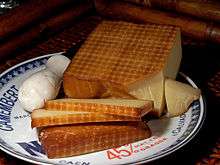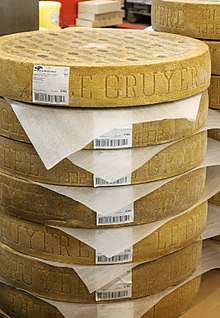Gruyère cheese
| Gruyère | |
|---|---|
 | |
| Country of origin | Switzerland |
| Region, town | Canton of Fribourg, Gruyères |
| Source of milk | Cows |
| Pasteurized | No |
| Texture | Hard |
| Aging time | 5-12 months (typical) |
| Certification |
Swiss AOC 2001-2013 Swiss AOP since 2013 |
|
| |
Gruyère (/ɡruːˈjɛər/ or /ɡrɪˈjɛər/; French pronunciation: [ɡʁyjɛʁ], German: Greyerzer) is a hard yellow cheese that originated in the cantons of Fribourg, Vaud, Neuchâtel, Jura, and Bern in Switzerland. It is named after the town of Gruyères. Before 2001, when Gruyère gained the appellation d'origine contrôlée (AOC, now AOP) status as a Swiss cheese, some controversy existed whether French cheeses of a similar nature could also be labelled Gruyère (French Gruyère-style cheeses include Comté and Beaufort).
Gruyère is sweet but slightly salty, with a flavor that varies widely with age. It is often described as creamy and nutty when young, becoming more assertive, earthy, and complex as it matures. When fully aged (five months to a year) it tends to have small cracks that impart a slightly grainy texture.[1]
Uses

Gruyère cheese is generally known as one of the finest cheeses for baking, having a distinctive but not overpowering taste. In quiche, Gruyère adds savoriness without overshadowing the other ingredients. It is a good melting cheese,[2] particularly suited for fondues, along with Vacherin Fribourgeois and Emmental. It is also traditionally used in French onion soup, as well as in croque-monsieur, a classic French toasted ham and cheese sandwich. Gruyère is also used in chicken and veal cordon bleu. It is a fine table cheese, and when grated, it is often used with salads and pastas. It is used, grated, atop le tourin, a type of garlic soup from France which is served on dried bread. White wines, such as Riesling, pair well with Gruyère. Sparkling cider and Bock beer are also beverage affinities.
Production

To make Gruyère, raw milk is heated to 34 °C (93 °F) in a copper vat, and then curdled by the addition of liquid rennet. The curd is cut up into pea sized pieces and stirred, releasing whey. The curd is cooked at 43 °C (109 °F), and raised quickly to 54 °C (129 °F).
The whey is strained, and the curds placed into molds to be pressed. After salting in brine and smearing with bacteria,[3] the cheese is ripened for two months at room temperature, generally on wooden boards, turning every couple of days to ensure even moisture distribution. Gruyère can be cured for 3 to 10 months, with long curing producing a cheese of intense flavor.
Gruyère in Switzerland
In 2001, Gruyère gained the Appellation d'origine contrôlée status. Since then the production and the maturation is defined in the Swiss law, and all Swiss Gruyère producers must follow these rules. To be accepted throughout Europe as an AOC, the "Interprofession du Gruyère" in Switzerland plans to make a transnational AOC with the French producers of Gruyère.
Gruyère around the world
Gruyère-style cheeses are very popular in Greece, where the local varieties are known as γραβιέρα (graviéra). Some Greek gruyères come from San Michálē (Αγίου Μιχάλη, "St. Michael's") from the island of Syros in the Cyclades, the Naxian varieties, that tend to be milder and more sweet and various graviéras from Crete.
Gruyère-style cheeses are also produced in the United States, Wisconsin with the name of Grand Cru, having the largest output.
Affinage
An important and the longest part of the production of the Le Gruyere Switzerland AOC is the affinage (French for maturation).
According to the AOC, the cellars to mature a Swiss Gruyère must have a climate close to that of a natural cave. This means that the humidity should be between 94% and 98%. If the humidity is lower, the cheese dries out. If the humidity is too high, the cheese does not mature and becomes smeary and gluey. The temperature of the caves should be between 13 °C (55 °F) and 14 °C (57 °F). This relatively high temperature is required for excellent quality cheese. Lower quality cheeses result from temperatures between 10 °C (50 °F) and 12 °C (54 °F). The lower the temperature is, the less the cheese matures, resulting in a texture that is harder and more crumbly.
Varieties

Le Gruyère Switzerland AOC has many different varieties, with different aged profiles, and an organic version of the cheese is also sold. There is a special variety that is produced only in summer on the Swiss Alps: the Le Gruyère Switzerland AOC Alpage.
Generally, one can distinguish the age profiles of mild/doux (minimum 5 months old) and réserve, also known as surchoix (minimum 10 months old). In Switzerland, other age profiles can be found, including mi-salé (7–8 months), salé (9–10 months), vieux (14 months), and Höhlengereift (cave aged), but these age profiles are not part of the AOC.
The French Le Brouère cheese, made in nearby Vosges, is considered a variant of Gruyère.[4]
Le Gruyère AOP Premier Cru
Le Gruyère Premier Cru is a special variety, produced and matured exclusively in the canton of Fribourg and matured for 14 months in humid caves with a humidity of 95% and a temperature of 13.5 °C (56.3 °F).[5]
It is the only cheese that has won the title of best cheese of the world at the World Cheese Awards four times: in 1992, 2002, 2005 and 2015.[6][7]
See also
- Brined cheese
- Culinary Heritage of Switzerland – an online encyclopedia
- List of cheeses
Notes and references
- ↑ Quimme, Peter (1976). THE SIGNET BOOK OF CHEESE.
- ↑ The Cook's Thesaurus: Semi-Firm Cheeses
- ↑ Fox, Patrick. Cheese: Chemistry, Physics and Microbiology. p. 200.
- ↑ Ridgway, J., Weinzweig, A., & Hill, S. (2004). The cheese companion: The connoisseur's guide. Philadelphia, Pennsylvania: Running Press
- ↑ www.vonmuhlenen.ch
- ↑ von Mühlenen et Cremo SA concluent une alliance
- ↑ Le Gruyère AOP Premier Cru crowned World Champion Cheese 2015
External links
| Wikimedia Commons has media related to Gruyère (cheese, Switzerland). |
| Wikisource has original text related to this article: |
- Gruyère cheese in the online Culinary Heritage of Switzerland database.
- An article on the history and controversy of Swiss versus French claims to Gruyère cheese.